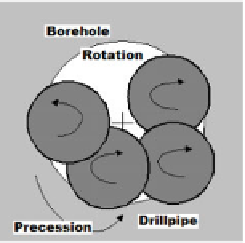Geology Reference
In-Depth Information
4.5.4.1 Partial differential equations.
To begin our discussion, we refer to Figures 4.5.1 and 4.5.2, bearing in
mind that four vibration modes dynamically interact. Let v(x,t) and w(x,t)
represent the two orthogonal lateral bending displacement modes, lying in
planes perpendicular to the drillstring axis, that are coupled by the torque T(x,t).
These modes can be shown to satisfy
EI
4
v/ x
4
+ (T
2
w/ x
2
)/ x + (N v/ x)/ x
+ kv +
A
2
v/ t
2
= q
(v)
(x,t)
v/ t +
(4.5.1)
EI
4
w/ x
4
- (T
2
v/ x
2
)/ x + (N w/ x)/ x
+ kw + w/ t + A
2
w/ t
2
= q
(w)
(x,t) (4.5.2)
where the q
(v)
(x,t) and q
(w)
(x,t) indicate that the right-hand-side “q” terms need
not be the same for both v and w bending modes. These equations will be
derived and justified at the end of this chapter.
(x,t)
v(x,t)
u(x,t)
w(x,t)
Transverse displaced position
x
Equilibrium position
Figure 4.5.1.
Coupled axial, torsional, and lateral displacements.
Figure 4.5.2.
Drillstring precession, rotation, torque reversal.


































Search WWH ::

Custom Search